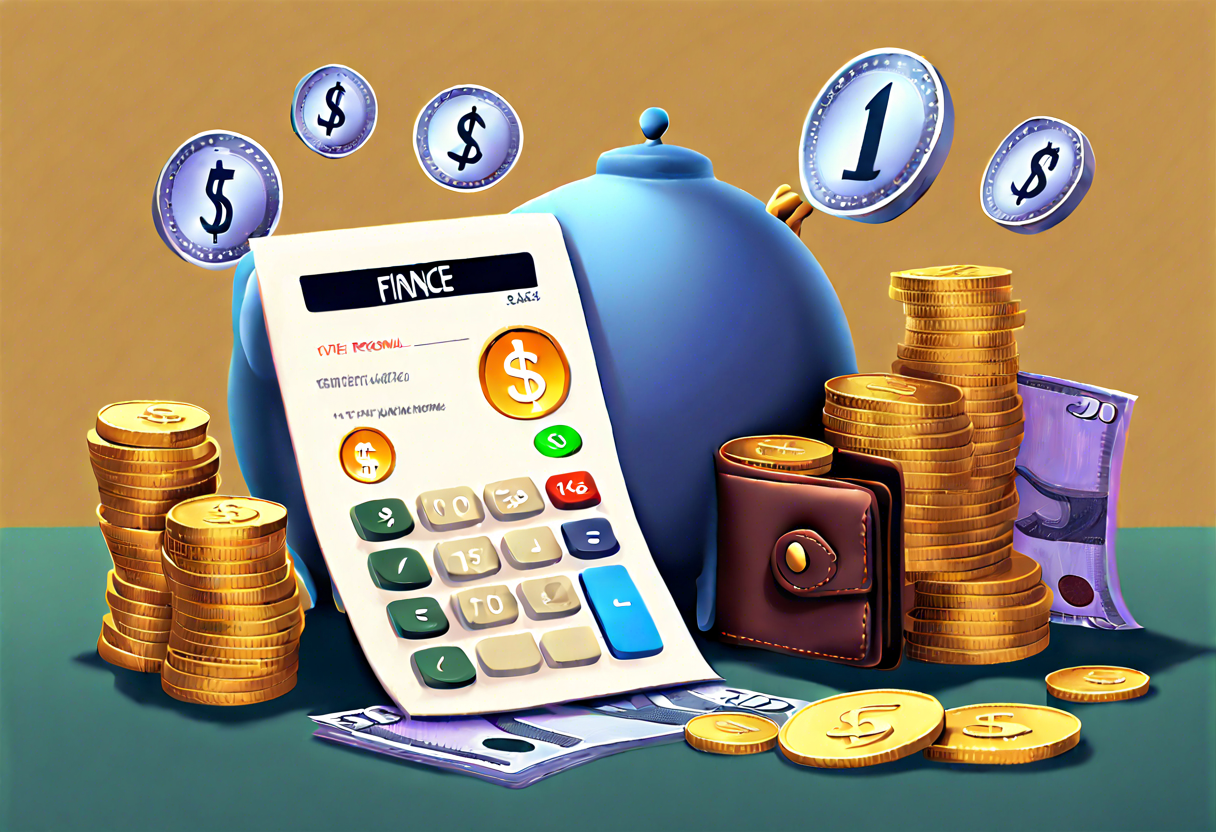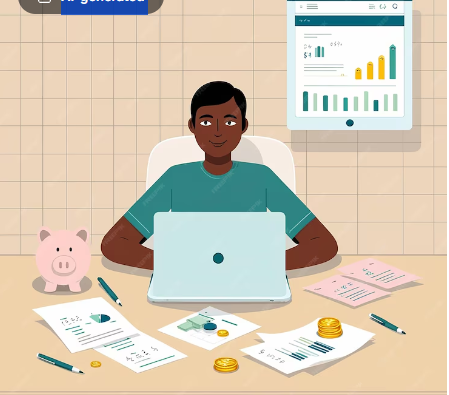What Are The 5 Basics Of Personal Finance?
The Fundamentals of Personal Finance
Table of Contents
Mastering the 5 Basics of Personal Finance
Managing your finances can be a daunting task, but understanding the fundamentals can make a significant difference in your financial well-being. In this article, we’ll explore the five basics of personal finance that every individual should prioritize.
Budgeting: The Foundation of Financial Stability
Budgeting is the cornerstone of personal finance. By creating a budget and sticking to it, you can gain control over your spending, identify areas for savings, and ensure that your money is being allocated towards your financial goals. Start by tracking your income and expenses, then categorize them into necessary and discretionary categories. This will help you identify areas where you can cut back and allocate funds towards savings or debt repayment.
Saving: Building a Secure Financial Future
Saving is crucial for both short-term and long-term financial stability. Establish an emergency fund that can cover at least three to six months’ worth of essential expenses. This will provide a safety net in case of unexpected events, such as job loss or medical emergencies. Additionally, consider setting aside a portion of your income for long-term goals, such as retirement or a down payment on a home.
Debt Management: Navigating the Terrain of Borrowing
Debt can be a significant burden, but with proper management, it can be a useful financial tool. Prioritize paying off high-interest debts, such as credit cards, as quickly as possible. Develop a strategy to tackle your debt, whether it’s the debt snowball or debt avalanche method. Avoid taking on new debt unless it’s for a specific, well-planned purpose, such as a mortgage or student loan.
Credit Building: Shaping Your Financial Reputation
Your credit score is a crucial factor in obtaining loans, credit cards, and even securing housing or employment. Strive to maintain a good credit score by making timely payments, keeping your credit utilization low, and monitoring your credit report for any errors or fraudulent activity. Regularly check your credit report and address any discrepancies to ensure your financial reputation remains strong.
Investment: Cultivating Long-Term Wealth
Investing is a powerful way to grow your wealth over time. Start by understanding your risk tolerance and investment goals. Consider diversifying your portfolio across different asset classes, such as stocks, bonds, and real estate, to minimize risk and maximize potential returns. If you’re unsure where to start, seek the guidance of a financial advisor who can help you develop a customized investment strategy.
By focusing on these five pillars of personal finance, you can take control of your financial future and achieve your financial goals. Remember, personal finance is a lifelong journey, and consistently applying these principles can lead to a more secure and prosperous financial life.
Budgeting: The Cornerstone of Financial Stability
Maintaining financial stability is a crucial aspect of personal well-being, and at the heart of this lies the practice of budgeting. Budgeting is the foundation upon which individuals can build a secure financial future, allowing them to control their expenses, save for the future, and achieve their financial goals.
The Importance of Budgeting
Budgeting serves as a roadmap for your financial journey, providing a clear understanding of your income and expenses. By tracking your spending and allocating your resources effectively, you can identify areas where you can cut back, allowing you to direct more funds towards savings, debt repayment, or other financial priorities. This level of control and visibility is essential for achieving long-term financial stability.
Establishing a Budgeting System
Creating a budgeting system that works for you is the first step towards financial mastery. Start by tracking your income sources and categorizing your expenses into essential, discretionary, and savings categories. This will help you gain a comprehensive understanding of your financial landscape and identify areas where you can optimize your spending.
Prioritizing Savings and Debt Repayment
One of the key pillars of a successful budget is the allocation of funds towards savings and debt repayment. By prioritizing these areas, you can build a financial safety net, reduce the burden of interest payments, and set yourself up for long-term financial freedom. Automating your savings contributions and creating a structured debt repayment plan can ensure that these crucial components are consistently addressed.
Embracing Flexibility and Adjustments
Budgeting is not a one-size-fits-all approach; it requires a certain degree of flexibility to adapt to the ever-changing nature of your financial landscape. Be prepared to regularly review and adjust your budget as your income, expenses, and financial goals evolve. This adaptability will ensure that your budgeting system remains effective and aligned with your current needs and priorities.
Cultivating Financial Discipline
Successful budgeting requires a strong sense of financial discipline. This involves resisting impulse purchases, sticking to your predetermined spending limits, and regularly reviewing your budget to ensure compliance. By developing these habits, you can build a solid foundation for long-term financial stability and achieve your financial aspirations.
Budgeting Tools and Resources
In the digital age, there are numerous budgeting tools and resources available to help you streamline the process. From budgeting apps to online spreadsheets, these tools can automate many of the tedious tasks, provide visual representations of your financial data, and offer valuable insights to help you make informed decisions.
Embracing a Holistic Approach
Budgeting is not just about numbers and spreadsheets; it’s about cultivating a mindset that prioritizes financial well-being. By integrating budgeting into your overall lifestyle and decision-making processes, you can create a harmonious balance between your financial goals and your day-to-day activities. This holistic approach will ensure that your budgeting efforts are sustainable and aligned with your long-term aspirations.
Budgeting is the cornerstone of financial stability, empowering individuals to take control of their finances, achieve their goals, and build a secure financial future. By embracing the principles of budgeting, you can unlock the path to financial freedom and unlock a world of financial possibilities.
Effective Debt Management Strategies
Prioritize Your Debt Payments
Effective debt management starts with prioritizing your debt payments. Make a list of all your outstanding debts, including credit card balances, loans, and any other financial obligations. Organize them by interest rate, with the highest rate at the top. This will help you focus on paying off the most expensive debt first, which can save you a significant amount of money in the long run.
Create a Budget and Stick to It
Creating a budget is a crucial step in managing your debt effectively. Start by tracking your income and expenses, identifying areas where you can cut back, and allocating those savings towards your debt payments. Be realistic and flexible with your budget, as unexpected expenses may arise. Stick to your budget as much as possible, and make adjustments as needed.
Utilize Debt Consolidation or Balance Transfers
If you have multiple high-interest debts, consider consolidating them into a single, lower-interest loan or balance transfer credit card. This can simplify your payments and potentially save you money on interest charges. However, be cautious of any fees associated with these options, and ensure that you can make the payments on time.
Increase Your Income
Finding ways to increase your income can also be an effective debt management strategy. This could involve taking on a part-time job, freelancing, or asking for a raise at your current job. Any additional income you generate can be directed towards paying off your debts more quickly.
Practice Debt Snowballing
The debt snowball method involves paying off your debts in order from smallest to largest, regardless of interest rates. This approach can provide a sense of momentum and accomplishment as you pay off each debt, which can motivate you to continue your debt reduction efforts.
Negotiate with Creditors
If you’re struggling to make your debt payments, consider negotiating with your creditors. Many creditors are willing to work with you to establish a more manageable payment plan or even reduce the interest rate on your debt. Be prepared to explain your financial situation and propose a realistic repayment plan.
Seek Professional Assistance
If you’re overwhelmed by your debt or unsure of the best approach, consider seeking the help of a financial advisor or a credit counseling service. These professionals can review your financial situation, provide personalized advice, and guide you through the debt management process.
Remember, effective debt management is a journey, and it may take time and consistent effort to achieve your goals. By implementing these strategies, you can take control of your finances, reduce your debt, and build a more secure financial future.
Building an Emergency Fund: A Safeguard Against Unexpected Expenses
Why Building an Emergency Fund is Essential
Having an emergency fund is a crucial aspect of personal finance that can provide a financial safety net during unexpected expenses or times of crisis. This fund serves as a buffer, allowing you to cover unforeseen costs without having to rely on credit cards, loans, or dipping into long-term savings.
The Importance of an Emergency Fund
Unexpected expenses can arise at any time, whether it’s a medical emergency, a car repair, or a job loss. Without a sufficient emergency fund, these situations can quickly become a financial burden, leading to stress, debt, and the potential to derail your long-term financial goals. By having a readily available source of funds, you can avoid the need to take on high-interest debt or make difficult decisions that could jeopardize your financial well-being.
Determining the Ideal Emergency Fund Size
The recommended size of an emergency fund can vary depending on your individual circumstances, but a general rule of thumb is to have enough to cover three to six months’ worth of living expenses. This amount can provide a cushion to help you weather unexpected events without disrupting your financial stability.
Building Your Emergency Fund Step-by-Step
Step 1: Assess Your Expenses The first step in building an emergency fund is to calculate your monthly living expenses. This includes rent or mortgage payments, utilities, groceries, transportation, and any other essential costs. Knowing your monthly expenses will help you determine the target amount for your emergency fund.
Step 2: Set a Savings Goal Once you have a clear understanding of your expenses, set a savings goal for your emergency fund. Aim to save the equivalent of three to six months’ worth of living expenses, depending on your personal situation and financial stability.
Step 3: Automate Your Savings Make the process of saving for your emergency fund as effortless as possible by setting up automatic transfers from your checking account to a dedicated savings account. This ensures that a portion of your income is directed towards your emergency fund before you have a chance to spend it.
Step 4: Stick to Your Plan Building an emergency fund takes time and discipline, so it’s important to stick to your savings plan. Avoid dipping into the fund for non-essential expenses, and be patient as your savings grow. Celebrate small milestones along the way to keep yourself motivated.
Step 5: Maintain and Replenish Once you’ve reached your emergency fund goal, don’t stop there. Continue to contribute to the fund regularly to maintain the recommended balance. Remember to review and adjust your savings plan as your financial situation changes, such as a change in income or living expenses.
The Benefits of Having an Emergency Fund
Having a well-stocked emergency fund provides several benefits, including:
- Financial Resilience: An emergency fund can help you weather unexpected financial storms, preventing you from having to rely on high-interest debt or jeopardize your long-term financial goals.
- Reduced Stress: Knowing that you have a financial safety net can provide peace of mind and reduce the stress associated with unexpected expenses.
- Flexibility: With an emergency fund, you have the flexibility to make decisions based on your needs, rather than being forced to make hasty financial choices.
- Improved Credit Score: By avoiding the need to take on debt during emergencies, you can maintain a healthy credit score, which can benefit you in the long run.
Building an emergency fund is a crucial step in achieving financial security and stability. By following the steps outlined above, you can create a reliable source of funds to protect yourself and your family from unexpected financial challenges. Remember, the key is to start small and be consistent in your savings efforts – over time, your emergency fund will grow, providing you with the peace of mind and financial resilience you need.
Investing for the Future: Securing Your Long-Term Financial Goals
Securing Your Financial Future: Key Strategies for Long-Term Investing
Achieving financial security and reaching your long-term goals requires a comprehensive approach to investing. By understanding the fundamentals of personal finance and implementing strategic investment practices, you can set yourself up for a prosperous future. Let’s explore the five essential elements of personal finance that will help you build wealth over time.
Budgeting and Saving
The foundation of financial stability lies in effective budgeting and consistent savings. Begin by tracking your income and expenses to identify areas where you can cut back and allocate more funds towards your savings. Establish a realistic budget that accounts for your essential needs, debt payments, and discretionary spending, leaving room for regular contributions to your savings and investment accounts.
Debt Management
Effectively managing debt is crucial for long-term financial success. Prioritize paying off high-interest debts, such as credit card balances, as quickly as possible to minimize the amount of interest you pay over time. Consider consolidating multiple debts into a single, lower-interest loan to simplify your payments and reduce the overall cost of your debt.
Emergency Fund
Building an emergency fund is a crucial safeguard against unexpected expenses. Aim to save enough to cover three to six months’ worth of living expenses, ensuring that you have a financial cushion to rely on in the event of job loss, medical emergencies, or other unforeseen circumstances.
Retirement Planning
Secure your long-term financial future by planning for a comfortable retirement. Take advantage of tax-advantaged retirement accounts, such as 401(k)s or individual retirement accounts (IRAs), and contribute regularly to maximize your savings and potential for growth. Consider seeking the guidance of a financial advisor to develop a personalized retirement strategy that aligns with your goals and risk tolerance.
Diversified Investments
Diversifying your investment portfolio is a fundamental strategy for managing risk and maximizing returns over the long term. Allocate your investments across a range of asset classes, including stocks, bonds, real estate, and alternative investments, to reduce your exposure to market volatility and capitalize on different growth opportunities.
By focusing on these five essential elements of personal finance, you can lay the groundwork for a secure and prosperous financial future. Remember, consistent and disciplined financial practices are the key to achieving your long-term goals and building wealth over time.
Conclusion
Managing your personal finances effectively is the foundation for achieving financial stability and reaching your long-term goals. By mastering the basics, you can take control of your money and build a secure financial future.
The first step in this journey is understanding the fundamentals of personal finance. This includes creating a budget, tracking your income and expenses, and learning to live within your means. Budgeting is the cornerstone of financial stability, allowing you to allocate your resources wisely and ensure that your spending aligns with your priorities.
Effective debt management is also crucial. Developing strategies to pay off high-interest debts, such as credit cards, can free up funds that can be redirected towards more productive purposes, like saving and investing. By reducing your debt burden, you’ll improve your financial health and increase your ability to reach your financial goals.
Building an emergency fund is another essential component of personal finance. Unexpected expenses, such as medical bills or car repairs, can quickly derail your financial plans if you’re not prepared. By consistently setting aside a portion of your income into a dedicated emergency fund, you can create a safety net that will protect you from these unforeseen events and help you maintain financial stability during difficult times.
Investing for the future is the final key aspect of personal finance covered in this article. Whether it’s saving for retirement, a down payment on a house, or your children’s education, investing your money wisely is crucial for securing your long-term financial goals. By understanding the different investment options available and developing a diversified portfolio, you can grow your wealth over time and ensure that you have the resources you need to achieve your dreams.
By focusing on these five fundamental areas of personal finance – budgeting, debt management, emergency fund building, and investing – you can take control of your financial future and set yourself up for success. Remember, personal finance is a lifelong journey, and the sooner you start, the better off you’ll be.
The journey to financial well-being may seem daunting at first, but by taking it one step at a time and staying committed to the process, you can achieve your goals and enjoy the peace of mind that comes with financial security. So, take the time to understand these personal finance basics, develop a plan, and start taking action today. Your future self will thank you for it.






